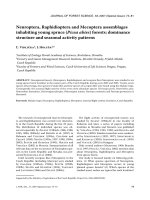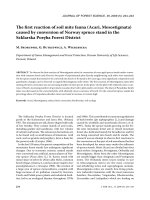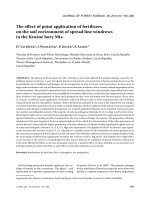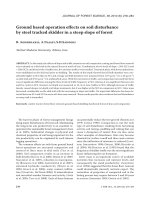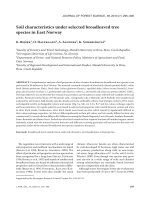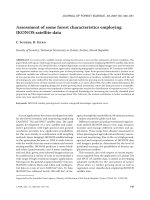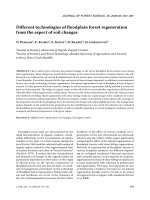Báo cáo lâm nghiệp: "Soil detritivore macro-invertebrate assemblages throughout a managed beech rotation" docx
Bạn đang xem bản rút gọn của tài liệu. Xem và tải ngay bản đầy đủ của tài liệu tại đây (1.01 MB, 10 trang )
Ann. For. Sci. 64 (2007) 219–228 219
c
INRA, EDP Sciences, 2007
DOI: 10.1051/forest:2006106
Original article
Soil detritivore macro-invertebrate assemblages throughout
a managed beech rotation
Mickaël H
*
, Michaël A
, Fabrice B, Pierre M, Thibaud D
¨
Université de Rouen, Laboratoire d’Écologie, ECODIV, UPRES-EA 1293, UFR Sciences et Techniques, 76821 Mont Saint Aignan Cedex, France
(Received 28 March 2006; accepted 28 September 2006)
Abstract – This work addresses the driving factors responsible for patterns in the detritivore macrofaunal communities of a managed beechwood
chronosequence (28 to 197 years old, Normandy, France). We investigated the variation patterns of density, biomass and diversities of detritivore
macrofauna throughout this rotation. Multivariate analyses were carried out to identify the main covariation patterns between species and some prop-
erties of their physical environment, and to describe the main ecological gradients constraining the macro-invertebrate community assembly. A total
of 6 earthworm, 6 woodlouse and 7 millipede species were found in the whole data set. Density, biomass and diversity were profoundly influenced by
forest ageing, mainly because of variation in humic epipedon spatial variability. Three groups of species were identified according to their environmen-
tal requirements. Some hypotheses regarding the external (related to management practices) or internal (related to inter-specific interactions) assembly
rules behind species assemblages are proposed, an approach which has rarely been used in soil ecology. Finally, the impact of forestry practices on soil
functioning through their impact on detritivore macro-invertebrate communities is discussed.
soil detritivore m acrofauna / community ecology / assembly rules / humic epipedon / forest management
Résumé – Les assemblages de macro-invertébrés détritivores du sol d’une rotation de futaie de hêtre. Ce travail a pour but d’identifier les facteurs
responsables des schémas de variation des communautés de la macrofaune detritivore d’une chronoséquence (28 à 197 ans) de futaie régulière de hêtre
(Normandie, France). Les modèles de variation de la densité, la biomasse et la diversité ont été recherchés. Les modèles de covariation entre les espèces
et certaines propriétés physiques du milieu ainsi que les gradients écologiques qui contraignent les assemblages de macro-détritivores ont été décrits à
l’aide d’analyses multivariées. En tout, 6 espèces de vers de terre, 6 espèces d’isopodes et 7 espèces de diplopodes ont été identifiées. La maturation du
peuplement de hêtre, principalement par les modifications de l’épisolum humifère, influence fortement les densité, biomasse et diversité. Trois groupes
d’espèces sont identifiés sur la base de leurs exigences environnementales. Quelques hypothèses sont proposées quant aux règles externes (liées aux
pratiques sylvicoles) et internes (liées aux relations interspéciques) qui contraignent la composition des assemblages d’espèces, cette approche ayant
jusqu’à présent été peu utilisée en écologie du sol. Enfin, l’impact des pratiques sylvicoles sur le fonctionnement du sol, au travers de leur impact sur
les communautés de macro-détritivores, est discuté.
macrofaune detritivore du sol / écologie des communautés / règles d’assemblages / épisolum humifère / gestion forestière
1. INTRODUCTION
Soil invertebrates are recognized as having a high func-
tional importance in soil processes and being responsible for
the provision of ecosystem goods and services such as or-
ganic matter decomposition, water cycling or primary pro-
ductivity [38]. These organisms are highly sensitive to nat-
ural disturbances and human practices [38]. Inadequate land
use may dramatically decrease their level of activity and/or
their community diversity, leading in some extreme cases to
major soil dysfunctioning and ecosystem degradation [23]. In
forest ecosystems, soil detritivores are considered an impor-
tant group of organisms, involved in the comminution of fresh
dead leaves and the stimulation of decomposer microflora,
with consecutive impacts on organic matter mineralisation and
humic epipedon functioning [45].
* Corresponding author:
Based on observations in semi-natural forests, Ponge
et al. [45] described the natural silvigenetic cycle as a two-step
trajectory shifting from an autotrophic functional phase to-
ward a heterotrophic one which markedly influences the avail-
ability of nutrients. In terms of ecosystem functioning, the
autotrophic phase is characterised by a great influence of tree
activity (photosynthesis, nutrient absorption) leading to the ac-
cumulation of organic matter on the forest floor (i.e. develop-
ment of moder humus forms). The heterotrophic phase is char-
acterized by an increase in soil-dwelling macro-invertebrate
activity which promotes the rapid disappearance of fresh lit-
ter (i.e. development of mull humus forms). In mountain
semi-natural spruce forests, parallel changes occur in vege-
tation, humus profiles and soil fauna communities [15, 16],
e.g. in young stands, soil macro-invertebrate communities
are dominated by epigeous taxa (many species of woodlice
and millipedes) while old stands host numerous populations
of earthworms. In the beech integral biological reserve of
Article published by EDP Sciences and available at or />220 M. Hedde et al.
Table I. Description of the fifteen selected stands reconstituting a silvicultural rotation by the SFTS procedure.
Stand age
(years)
Last cut year Wood uptake
(m
3
.ha
−1
since 1980)
Silvicultural phase
28 1997 127.3 First thinning
28 1998 191.8 First thinning
30 1996 235.1 First thinning
61 1997 105.0 Refining
61 1997 112.6 Refining
65 1998 128.4 Refining
118 1998 138.7 Amelioration
127 1995 149.0 Amelioration
136 1995 162.4 Amelioration
147 1993 167.7 Amelioration
177 1996 255.3 Regeneration
179 1991 93.4 Regeneration
182 1998 127.1 Regeneration
197 1997 193.6 Regeneration
197 1997 115.8 Regeneration
Fontainebleau forest (France), Arpin et al. [4] described simi-
lar patterns and showed successional changes in humus, earth-
worm, nematode and vegetation communities as the result of
forest dynamics.
The recent awareness of a global biodiversity crisis has un-
derscored the urgent necessity of maintaining ecosystem in-
tegrity and functioning [36]. In forest ecosystems the conser-
vation of biological diversity has been identified as a major
goal of sustainable silvicultural management [39]. Intensively
managed forests (e.g. planted, mono-specific, even-aged) are
interesting models where vertical stratification of vegetation
and tree composition are reduced to their simplest expression,
making them about the most simplified forests [7]. In such sys-
tems, much attention has been paid to plant community diver-
sity [5, 12] and most works on soil detritivore invertebrates
in forest ecosystems were description of species composi-
tion [20, 26,27] or comparative studies of communities across
humus types [3, 47, 48]. To date, only few authors addressed
successional pathways during forest rotation [22,30,52].
Hence, to identify sustainable management practices, it is
now urgent to understand how soil invertebrate communities
are assembled and how species assemblage diversity responds
to human activities in intensively managed forests. In this con-
text, the present paper aims at describing community patterns
of detritivore macro-invertebrates (earthworms, woodlice and
diplopods) in an even-aged beech forest rotation developed on
loamy soil. Our research hypothesis was that changes in de-
tritivore community occur and reflect the expected shift from
autotrophic to heterotrophic functional phases. We addressed
several aspects of community ecology: (i) patterns of varia-
tion in density and biomass, (ii) several dimensions of com-
munity diversity (structure, composition and organization) and
(iii) relationships between species and environmental factors
throughout this silvicultural cycle.
2. MATERIALS AND METHODS
2.1. Study sites
The study was carried out in even-aged pure beech stands of the
“Forêt domaniale d’Eawy” (Haute-Normandie, France). The climate
is temperate oceanic with a mean annual temperature of +10
◦
Cand
a mean annual precipitation of 800 mm [19]. All stands were located
on a plateau with more than 80 cm of loess as parent material. Soils
are LUVISOLS, according to the “Référentiel pédologique” [1] and
equivalent to LUVISOLS in the world reference base [34]. Stands
were managed by the French forestry service (ONF), essentially for
beech timber harvesting.
In order to represent all phases of a silvicultural cycle, we used
a space-for-time substitution procedure. Fifteen stands were chosen
encompassing the following silvicultural phases: first thinning (Ft),
refining (Rf), amelioration (Am) and regeneration (Rg) (Tab. I, mean
ages are 29, 63, 132, and 186 years, respectively). The number of
plot replicates per beech growth phase ranged from 3 to 5 and was
a function of the specific duration of each phase (Tab. I). This set
of stands was assumed to reconstitute the theoretical chronosequence
that characterises a silvicultural cycle in the Eawy forest. The silvi-
cultural phases were described by Aubert et al. [5].
2.2. Macro-invertebrate sampling
In April 2003, three samples were taken in each selected stand.
Sampling points were 10 m apart from each other, and were located
away from vehicle tracks and as far as possible from tree trunks to
avoid any acidification due to organic matter accumulation [13]. The
macrofauna was sampled at each point on a 1 m
2
area, the method-
ology comprised a combination of hand sorting and chemical extrac-
tion [9]:
1 – First, the holorganic layer was removed and brought to the
laboratory to extract invertebrates by hand sorting after washing;
Soil detritivore macro-invertebrate assemblages 221
Table II. Coding for the fourteen environmental variables used in co-inertia analysis.
Environmental variable Code Environmental variable Code
Total humus depth Humusd Total humus weight Humusw
Minimum OL depth minLd Beechnut weight BNw
Maximum OL depth maxLd Beech leaves litter weight BLw
[OL]/[total humus]depth ratio %Ld Deadwood weight DWw
Minimum OF+OH depth maxFHd Herbaceous layer litter weight HLw
Maximum OF+OH depth minFHd Herbaceous layer biomass HLb
[OF+OH]/[total humus]depth ratio %FHd Soil pH Soil pH
2 – Then, 30 L of 4% formaldehyde were applied to the same
area at the rate of 10 L every 15 min [29].
3 – Afterwards, a soil monolith of 25 × 25 × 30 cm was dug out
in the middle of the area and hand sorted in the field. This was done
to sample species or individuals less sensitive to formaldehyde and to
calibrate the density and biomass data if necessary [40].
All extracted invertebrates were stored in 4% formaldehyde. Lum-
bricida, Isopoda and Diplopoda were identified to species level ac-
cording to Bouché [18], Demange [31] and Hopkins [37], respec-
tively. Invertebrates were counted and weighed to calculate species
density and biomass at each sampling point. In this paper, litter in-
vertebrates will refer to individuals sampled in holorganic layers and
soil invertebrates to those found in the organo-mineral layer.
2.3. Descriptive variables of community
For each silvicultural phase, we calculated mean density, biomass
and structural, compositional and organizational diversity indices.
This enabled us to provide a model of variation pattern and to iden-
tify the main mechanisms of species co-existence throughout the sil-
vicultural rotation [2, 10]. Four indices of diversity were calculated
for each silvicultural phase:
(1) SR, the mean species richness per sample (i.e. the mean num-
ber of species identified per sampled area [43])
(2) J
, the mean Shannon Evenness index, a structural index which
reflects the species dominance level [51]:
J
=
H
H
max
(3) WPS, the mean Within-Phase Similarity, a measure of composi-
tional diversity which estimates pairwise similarity among all records
of a silvicultural phase. It was computed using the Sørensen in-
dex [53]
Sørensen index =
2c
/
(2c + a + b)
where a is the number of species found in sample A, b the number of
species found in sample B and c the number of species that occur in
both samples.
(4) FD, the conditional variance of records on the first two axes of
Correspondence Analysis (see details in the statistical analysis sec-
tion [24, 54]):
FD =
i
j=1
p
j/i
C
k
( j) − L
(c)
k
(i)
2
where p
j/i
is the conditional relative frequency of sample i for species
j, L
(c)
k
(i) the sample ordination on gradient by averaging, C
k
( j)the
species ordination on gradient by weighted averaging. It assesses the
degree of community organization by measuring species dispersion
along correspondence analysis axes and thus reflects the coherence
of species assemblages with reference to ecological gradients. As an
example, high FD values indicate high species dispersion along the
ecological gradient, i.e. low ecological coherence of species assem-
blages.
2.4. Description of environmental variables
Humus was described according to the French nomenclature at
each sampling point before invertebrate extraction [1]. We thus distin-
guished mull (mesomull + oligomull), moder (eumoder + dysmoder)
and intermediate mull-moder forms (dysmull + hemimoder). Four-
teen parameters were also described at each point and used as en-
vironmental variables (Tab. II). Herbaceous vegetation biomass was
sampled on 1 m
2
quadrats, oven-dried (40
◦
C) and weighed. Four
soil cores (5 cm depth, 10 cm diameter) were sampled on the cor-
ners of the square meter and used to assess soil pH (1:2.5 soil/liquid
mixture). After litter-invertebrate sampling by washing-sieving in the
laboratory, remaining litter components (beechnuts, herbaceous lit-
ter, beech litter, dead wood) were separated, oven-dried at 40
◦
Cand
weighed.
2.5. Statistical analyses
Mean differences in density, biomass and diversity were tested us-
ing Tukey (HSD) test at the significant level of p = 0.05. Prior to
analysis, data normality was tested using the Wilk-Shapiro test at the
significance level of p = 0.05 and a logarithmic transformation was
used to homogenize variances if necessary. These analyses were per-
formed with R Software [46].
Density data were analysed by Correspondence Analysis (CA) to
identify community gradients [24, 54]. Species occurring in less than
3% of the sampling points were removed from the data set, so the
final matrix consisted of 45 lines (sampling points) and 14 columns
(identified species retained after matrix screening). ‘Species habitat
amplitudes’, i.e. the dispersion of records in which the considered
species occurs, were calculated for each species on each interpretable
CA axis.
222 M. Hedde et al.
Table III. List of detritivore macro-invertebrate species identified in the Eawy Forest rotation and their corresponding code.
Phylogenic group List of taxa Code
Oligochaeta (Lumbricidae)
Dendr odrilus rubidus (Savigny, 1826) Drub
Dendr obaena octaedra (Savigny, 1826) Doct
Lumbricus rubellus Hoffmeister, 1843 Lrub
Lumbricus eiseni Levinsen, 1884 Leis
Lumbricus castaneus (Savigny, 1826) Lcas
Octolasium cyaneum (Savigny, 1826) Ocya
Isopoda Trichoniscus pusillus Brandt , 1883 Tpus
Oniscus asellus Linnaeus, 1758 Oase
Philoscia muscorum (Scopoli, 1763) Pmus
Porcellio scaber Latreille, 1804 Psca
Porcellio dilatatus Brandt , 1833 Pdil
Trachelipus rathkei (Brandt , 1833) Trat
Diplopoda Glomeris marginata (Villiers, 1789) Gmar
Chor deuma sylvestre C.L. Koch, 1847 Csyl
Polydesmus sp. Latreille, 1802 Poly
Iulus scandinavius Latzel, 1884 Isca
Tachypodoiulus albipes (C.L. Koch, 1838) Talb
Cylindroiulus latestriatus (Curtis, 1844) Clate
Cylindroiulus nitidus Verhoeff, 1891 Cnit
A co-inertia analysis (CoIA) was performed to explore co-
variation patterns between community and environmental data. This
statistical tool is described as the best way to couple two data ta-
bles (records × species and records × environmental variables). Envi-
ronmental data were previously analysed with a principal component
analysis (PCA) of a matrix containing 45 lines (sampling points) × 14
columns (environmental variables). The co-inertia analysis was then
run on the CA of faunal data and the PCA of environmental variables
to (i) isolate new axes in both multidimensional spaces and (ii) create
a factorial plane which distorts as little as possible the structure of
each initial data set and enables their simultaneous ordination. The
CoIA was validated by a Monte-Carlo permutation test (n = 1000,
p < 0.05). Multivariate analyses and corresponding charts were per-
formed using ade4 package for R [46, 55].
3. RESULTS
3.1. Density and biomass patterns
A total of 19 species belonging to the investigated groups
of detritivore macro-invertebrates were found in the whole
sample set, including 6 earthworm, 6 woodlouse and 7 mil-
lipede species (Tab. III). Six species were sampled only in
holorganic layers (Trichoniscus pusillus, Trachelipus rathkei,
Porcellio scaber, Cylindroiulus latestriatus, C. nitidus and
Tachypodoiulus albipes). No anecic earthworm species were
sampled in these superficial layers and only one individual
of endogeic earthworm species (O. cyaneum) was found. All
other species were found in both holorganic and organo-
mineral layers. Total density and biomass did not present
significant differences between silvicultural phases. Density
and biomass of litter-dwelling communities significantly de-
creased from Ft to Rg stages (Fig. 1). Density and biomass
of soil-dwelling communities (i.e. invertebrates sampled in
organo-mineral layers) remained constant throughout the rota-
tion. Density and biomass were significantly higher for litter-
dwelling than for soil-dwelling species in Ft and Rf phases
while no differences were found in Rg phase (Fig. 1).
3.2. Diversity patterns
Except for Dendrodilus octaedra which was not present
in the amelioration phase, all species occurred at all silvicul-
tural stages. This indicates that there was no species turn-over
throughout the studied rotation. Mean SR of total and litter
communities were lower in Rg when compared to other phases
while no significant change was observed for soil-inhabiting
invertebrates (Fig. 1). Except for Rg, mean SR was also sig-
nificantly higher for litter-dwelling invertebrates than for soil-
dwelling invertebrates. Mean J
was very high (> 0.80) and
did not differ between silvicultural phases whatever the layer
considered (Fig. 1), although it was higher in litter than in
soil communities in Rf and Am. Mean WPS of the total litter-
dwelling communities was higher in Rf and lower in Rg, while
it remained constant for soil-dwelling invertebrates (Fig. 1).
It was also higher for litter-dwelling than for soil-dwelling
species in Ft and Rf phases (Fig. 1). The organizational di-
mension of diversity, measured by the mean FD of each phase,
significantly increased from Ft and Rf to Rg along CA1. No
differences appeared between stages for FD on CA2 (Fig. 1).
Soil detritivore macro-invertebrate assemblages 223
Figure 1. Mean values of community descriptors (bars are standard deviations) for total, litter- and soil-dwelling detritivore macro-invertebrate
assemblages at each silvicultural phase. Different letters indicate significant differences at p < 0.05 (Tukey HSD test) between silvicultural
stages. Asterisks indicate statistical differences between soil- and litter layer assemblages (ns not significant, * p < 0.05, ** p < 0.01, ***
p < 0.001).
3.3. Correspondence analysis on total detritiv ore
invertebrate densities
The first two axes of CA accounted for 48.4% of the to-
tal variance, with 29.5% and 18.9% for the first (CA1) and
the second axes (CA2), respectively. The next axes displayed
small eigenvalues and were not considered for the interpreta-
tion (Fig. 2a).
CA1 ordinated sampling points according to a gradient
from Ft to Rg stands (Fig. 2b). Sampling points with nega-
tive scores on CA1 were mainly mull-moder and moder hu-
mus whilst those with positive scores were dominated by mull
humus (Tab. IV). Species ordination and species ‘habitat am-
plitudes’ opposed: (a) a group of species with negative scores
(i.e. Philoscia muscorum, Glomeris marginata and Iulus scan-
dinavius); to (b) two species with high positive scores (i.e.
Lumbricus eiseni and Dendrobaena octaedra) (Figs. 2c and
2d). Most of the other taxa (e.g. Chordeuma sylvestre; Onis-
cus asellus; Dendrodrilus rubidus) were close to the origin,
meaning that their contribution to this axis was low (Figs. 2c
and 2d). CA1 was interpreted as the response of macro-
invertebrate communities to the gradient of forest maturation.
Sampling point ordination along CA2 did not follow a
simple and easily interpretable scheme as for CA1. Instead,
samples with positive and negative coordinates on CA2 were
found in all of the four silvicultural stages of the study
224 M. Hedde et al.
Figure 2. Results of Correspondence Analysis carried out on the matrix of detritivore macrofauna density (first factorial plane): (a) eigenvalue
diagram; (b) site ordination with representation of the barycentres for each silvicultural phase; (c) species ordination; (d) species ‘habitat
amplitude’ on the first two axis of the CA. Coding for species is given in Table III.
Table IV . Percentage of mull, mull-moder and moder humus forms
in groups of points defined by their coordinates on the two first CA
axes.
Points with: Mull (%) Mull-moder (%) Moder (%)
Positive score on CA1 15.4 46.2 38.5
Negative score on CA1 73.7 10.5 15.8
Positive score on CA2 25.0 25.0 50.0
Negative score on CA2 57.1 38.1 4.2
(Fig. 2b). Sampling points with negative scores on CA2 were
mainly mull humus while those with positive scores were
preferentially moder humus (Tab. IV). Species ordination and
species ‘habitat amplitude’ opposed 3 earthworms species
with high negative scores (L. rubellus, L. eiseni and D. octae-
dra) to other species with low positive or negative coordinates,
while L. castaneus and I. scandinavius had as intermediate po-
sition (Figs. 2c and 2d). CA2 was assumed to reflect the effect
of humus spatial variability on the presence of some earth-
worms species.
3.4. Species-env ironment relationships
The first two axes of the CoIA (CoIA1 and CoIA2) ac-
counted for 60.6% and 18.1% of the total co-variance, respec-
tively (Fig. 3a). The first axes of both CA and PCA were highly
correlated to CoIA1 while the second ones were opposed on
CoIA2 .
CoIA1 was interpreted as the effect of forest ageing on envi-
ronmental parameters and detritivore macro-invertebrate com-
munities. It opposed deadwood weight, beech litter weight and
total humus depth and weight to herbaceous layer biomass and
litter weight, soil pH and beechnut weight (Fig. 3b). Species
such as P. muscorum, G. marginata, I. scandinavius had strong
negative contributions to this axis while most other species dis-
played low positive or negative coordinates (Fig. 3c).
CoIA2 was identified as the result of humus spatial variabil-
ity. Minimum and maximum OL depth, total humus depth and
OL/total humus depth ratio were opposed to total and beech
litter weight, minimum OF+OH depth and OF+OH/total hu-
mus depth ratio (Fig. 3b). This axis opposed the woodlice
P. muscorum (negative score) to a group of species with pos-
itive scores, mainly L. eiseni, T. albipes, G. marginata and
D. octaedra (Fig. 3c).
4. DISCUSSION
4.1. Invertebrate-environment relationships
Multivariate analyses highlight the impact of forest stand
ageing through modifications in the vertical and horizontal
Soil detritivore macro-invertebrate assemblages 225
Figure 3. Results of Co-Inertia Analysis between density and environmental data sets (first factorial plane): (a) eigenvalue diagram; (b) en-
vironmental variable ordination; (c) species ordination. Coding for environmental variables is given is Table II, coding for species is given in
Table III.
distribution of the resources of soil fauna [6]. Management
practices may result in high environmental variability through
e.g. local use of pesticides, canopy opening or soil distur-
bance [11, 14]. Local natural events such as storms may also
be of importance [35, 41]. Coupling correspondence analy-
sis with the co-inertia interpretation allows us to discriminate
three groups of species with specific environmental require-
ments:
(1) The millipedes C. sylvestre, C. latestriatus and Poly-
desmus sp., the isopods T. pusillus and O. asellus and the earth-
worm D. rubidus dominated in young stands. These species
were associated with deep OF+OH layers and abundant dead-
wood and beech leaf mass (Fig. 4). They were preferentially
found in moder humus with moist, cool and buffered microcli-
mate [17, 56], which dominated Eawy’s closed-canopy stands
(Tab. III).
(2) The millipedes I. scandinavius, T. albipes and
G. marginata and the woodlouse P. muscorum had the highest
relative densities in old stands dominated by mull humus and
were linked to high herbaceous biomass and litter weight even
though they differ in horizon preference. While P. muscorum
needed the developmentof OF layer, G. marginata and I. scan-
dinavius appeared to prefer mull-like humus (high OL/total
depth ratio). These latter species are characterized by their
ability to roll up and/or to burrow and by their exoskeleton
impermeability, which confers them a high resistance to dry
conditions. They are therefore particularly adapted to mull-
like conditions with lower litter thickness, higher light inten-
sity and higher soil dryness [17,33].
(3) The earthworms L. eiseni and D. octaedra were opposed
to the other detritivore species. This may be due to their strong
preference for mull-like humus with deep OL layer whatever
the silvicultural phase. On the other hand, L. castaneus and
L. rubellus, presented weak relationships with environmen-
tal variables, even though they were preferentially located in
mull-like conditions.
4.2. Factors that control detritivore invertebrate
communities
The lack of change in species composition throughout the
Eawy rotation may reflect the combined effect of some silvi-
cultural practices which may have dramatic impacts on bur-
rowing earthworms, e.g. the mono-culture of a soil-acidifying
tree species on acidic soil, or the superficial tillage sometimes
used to assist natural regeneration [11]. Moreover, Aubert
et al. [5] showed a lack of pioneer and post-pioneer tree species
(e.g. Salix sp., Betula sp., Carpinus betulus) at the junction be-
tween old and new beech generations. These litter-improving
species favourably influence the quality of resources for detri-
tivore invertebrates [8]. Hence, the composition of detritivore
macro-invertebrate assemblages of Eawy forest rotation may
be explained by a few habitat constraints linked to forest man-
agement.
On the other hand, the species richness was low, as reported
by several authors in Western European forests (Tab. V). The
species number of both woodlice and litter-dwelling earth-
worms is roughly about c.a. 4–5 species, while soil-dwelling
earthworm and millipede species richness appears to be more
variable. Species richness limitation in epigeic earthworms
and woodlice suggests non-linear relationships between local
and regional richness, a trend which is rarely observed in nat-
ural communities where local richness is usually determined
by the size of the regional pool. This suggests that compe-
tition may reduce the number of coexisting species [21, 57].
More research is now needed to define how external factors
and species interactions account for the observed community
patterns. This will require larger data sets and the use of rele-
vant statistical tools like e.g. null model analyses.
4.3. Mechanisms of community assembly
The patterns of community diversity described herein
are relevant to exemplify assembly rules of detritivore
226 M. Hedde et al.
Table V . Species richness of earthworms (litter- and soil-dwelling), woodlice and millipedes in different western European forests.
Forest, Country Parent rock References Management Main tree Litter-dwelling Soil-dwelling Woodlice Millipedes
species earthworms earthworms
Ardennes, Belgium Limestone [44] Semi-natural Beech 5 5 – –
Ardennes, Belgium Limestone [20] Not described Oak and beech – – 5 11
Ardennes, Belgium Schists [28] Not described Beech 4 2 4 6
and sandstones
Eawy, France Loess This work Even-age Beech 5 1 6 8
Eawy, France Loess [6] Even-age Beech 4 0 4 9
Fontainebleau, Schists [42] Coppice with Oak – – 5 –
France and sandstones standard
Fougère, France Vire granite [30] Even-age Beech 4 1 – –
Lyons, France Loess [6] Even-age Beech and 5 0 4 9
hornbeam
Orléans, France Sandstones [26] Not described Oak 2 4 – 15
Orléans, France Sandstones [27] Not described Oak and beech – – – 13
Orléans, France Sandstones [3] Not described Oak – – – 6
macro-invertebrate communities [2, 10, 32]. These rules may
be related either to factors external to the community (i.e. asso-
ciated with habitat constraints acting as environmental filters)
or to the internal community dynamics itself (i.e. associated
with interspecific relationship constraints) [57]. Thus, species
of detritivore macro-invertebrates may co-occur thanks to spa-
tial segregation (i.e. without interspecific interactions) or co-
exist through niche partitioning (e.g. variability in resources
use) [50]. Three main stages of community assembly are high-
lighted by our results:
(1) First thinning and refining phases exhibited very sim-
ilar high values of density, biomass and SR, except for WPS
which was greater in Rf. The low FD with regard to the forest
maturation gradient (CA1) indicated a high ecological coher-
ence of these species assemblages. This may reflect niche com-
plementarity in equilibrium conditions with regard to resource
utilization. The low ecological coherence on CA2 emphasizes
the role of the spatial variability of humus forms in community
assembly. However, our results do not allow us to clearly sepa-
rate the two underlying mechanisms: co-occurrence of species
under environmental micro-heterogeneity or co-existence after
ecological organization by niche partitioning (e.g. species spe-
cialization for a given litter horizon or a given organic particle
size).
(2) Amelioration phase represented a transition between the
first stage and regeneration. Although not always statistically
significant, this phase was characterized by a decrease in all
community indices but evenness and FD. A reasonable hy-
pothesis is that past and current management locally (i.e. at the
community scale) led to assemblages which contain species
selected by habitat constraints (lower mean SR), whereas the
humus variability at the silvicultural phase scale allowed a
high number of species to occur. These results thus suggest
that, in Am phase, many species co-occur because a mosaic of
different humus forms results in a high spatial variability of re-
sources and allows a high level of species spatial segregation.
(3) In regeneration phase, low values of community in-
dices are probably due to changes in trophic and habitat re-
sources caused by the shelterwood cut. Low values of WPS
and low ecological coherence in species assemblages reveal
an important variability in species assemblage composition
in non-equilibrium conditions. Number of processes involved
in regeneration practices present different spatio-temporal ex-
tent which may overlap leading to high spatial variability. This
may explain why all species found in the whole rotation were
present in this phase, each of them founding adequate envi-
ronmental conditions for survival. We thus assumed species to
co-occur under spatial segregation.
4.4. Implication for humic epipedon functioning and
management practices
From a functional view-point, our results refute the hypoth-
esis of Ponge et al. [45] which predicts community changes
during forest rotations. In fact, no species turn-over was ob-
served and no burrowing earthworms colonized the soil in the
older stands of the rotation. Furthermore, detritivore inverte-
brate density and biomass decreased with stand ageing, con-
versely to the theory pattern. This forest rotation doesn’t en-
compass any shift from litter-dweller-dominated community
in young and mature stands (autotrophic phase), towards soil-
dwelling-dominated communities in regeneration stands (het-
erotrophic phase). These results are important features as far
as the implications for sustainable management are concerned.
Eawy intensive beech rotation favours the detritivore species
richness and composition similarity to the detriment of the ex-
pected shift in functional phases.
On the other hand, mull humus occurred in the old stands
despite the absence of (i) soil-dwelling earthworms and
(ii) early successional, litter-ameliorant tree species [5]. This
result is of particular importance from a management view-
point as changes in humus profile are considered a key factor
Soil detritivore macro-invertebrate assemblages 227
of tree renewal patterns in beech regeneration [25, 44]. Soil-
dwelling earthworm activities enhance microbial decomposer
functions (decomposition and mineralization of organic mat-
ter, see e.g. Scheu et al. [49]) and lead to a ‘functional’
mull humus [16, 45]. The presence of mull humus devoid of
anecic earthworms suggests that forest management practices
(mainly canopy openning and soil disturbance) may (i) de-
crease litterfall and (ii) activate organic matter mineralisation.
These processes lead to the formation of a “practices-induced
mull humus” with quite different functional features when
compared to a “true functional mull humus”. For instance,
the bio-macro-structured A horizon, which results from earth-
worm bioturbation and may favour tree seedling establishment
was lacking in Eawy’s regeneration stands. Further research
should now investigate if future stands coming from currently
assisted natural regeneration will follow similar successional
trends than stands coming from artificial plantations such as
these used in our sampling design.
Acknowledgements: We thank our colleague Estelle Langlois
(ECODIV) for useful comments on an early version of the
manuscript, the Office National des Forêts who kindly allowed us
access to the Forêt Domaniale d’Eawy, and the Conseil Régional de
Haute-Normandie for the financial support allowed to Mickaël Hedde
Ph.D. thesis.
REFERENCES
[1] AFES, A sound reference base for soils, INRA Editions, Paris,
1998.
[2] Alard D., Poudevigne I., Diversity patterns in grasslands along a
landscape gradient in north-western France, J. Veg. Sci. 11 (2000)
287–294.
[3] Arpin P., David J.F., Guittonneau G.G., Kilbertus G., Ponge J.F.,
Vannier G., Influence du peuplement forestier sur la faune et la mi-
croflore du sol et des humus. I. Description des stations et étude de
la faune du sol, Rev. Ecol. Biol. Sol 23 (1986) 89–118.
[4] Arpin P., Ponge J F., Faille A., Blandin P., Diversity and dynamics
of eco-units in the biological reserves of the Fontainebleau forest
(France): contribution of soil biology to a functional approach, Eur.
J. Soil Biol. 34 (1998) 167–177.
[5] Aubert M., Alard D., Bureau F., Diversity of plant assemblages in
managed temperate forests: a case study in Normandy (France), For.
Ecol. Manage. 175 (2003) 321–337.
[6] Aubert M., Hedde M., Decaëns T., Bureau F., Margerie P.,
Alard D., Effects of three canopy on earthworms and other
macro-invertebrates in beech forests of Upper Normandy (France),
Pedobiologia 47 (2003) 904–912.
[7] Aubert M., Margerie P., Ernoult A., Decaens T., Bureau F.,
Variability and heterogeneity of humus forms at stand level: com-
parison between pure beech and mixed beech-hornbeam forest,
Ann. For. Sci. 63 (2006) 177–188.
[8] Augusto L., Ranger J., Binkley D., Rothe A., Impact of several com-
mon tree species on forest fertility, Ann. For. Sci. 59 (2002) 233–
253.
[9] Baker G., Lee K.E., Earthworms, in: Carter M.R. (Ed.), Field sam-
plings and methods of analysis, Lewis Publishers, Boca Raton,
1993, pp. 359–371.
[10] Balent G., Construction of a reference frame for studying changes
in species composition in grasslands: the example of an old field
succession, Options Medit. 15 (1991) 73–81.
[11] Ballard T.M., Impacts of forest management on northern forest
soils, For. Ecol. Manage. 133 (2000) 37–42.
[12] Bengtsson J., Nilsson S.G., Franc A., Menozzi P., Biodiversity dis-
turbances ecosystem function and management of European forests,
For. Ecol. Manage. 132 (2000) 39–50.
[13] Beniamino F., Ponge J.F., Arpin P., Soil acidification under the
crown of oak trees. I. Spatial distribution, For. Ecol. Manage. 40
(1991) 221–232.
[14] Bergès L., Chevallier R., Dumas Y., Franc A., Gilbert J M., Sessile
oak (Quercus petrae Liebl.) site index variations in relation to cli-
mate, topography and soil in even-aged high-forest in northern
France, Ann. For. Sci. 62 (2005) 391–402.
[15] Bernier N., Ponge J.F., Dynamique et stabilité des humus au cours
du cycle sylvogénétique d’une pessière d’altitude, C.R. Acad. Sci.
Paris, Série III 316 (1993) 647–651.
[16] Bernier N., Ponge J.F., Humus form dynamics during the silvige-
netic cycle in a mountain spruce forest, Soil Biol. Biochem. 26
(1994) 183–220.
[17] Blower J.G., Millipeds and centipeds as soil animals, in: Kevan
K.M. (Ed.), Soil biology, Butterworths, 1955, pp. 138–151.
[18] Bouché M., Lombriciens de France, Écologie systématique, INRA
Éditions, Paris, 1972.
[19] Brêthes A., Catalogue des stations forestières du nord de la Haute-
Normandie, ONF, Paris, 1984.
[20] Branquart E., Kime R.D., Dufrêne M., Tavernier J., Wauthy
G., Macroarthropod-habitat relationships in oak forests in south
Belgium. I. Environment and communities, Pedobiologia 39 (1995)
243–263.
[21] Caley M. J., Schluter D., The relationship between local and re-
gional diversity, Ecology 78 (1997) 70–80.
[22] Chauvat M., Soil biota during forest rotation: Successional changes
and implications for ecosystem performance, Ph.D. thesis, Justus-
Liebig-Universität Gießen.
[23] Chauvel A., Grimaldi M., Barros E., Blanchart E., Desjardins T.,
Sarrazin M., Lavelle P., Pasture damage by an Amazonian earth-
worm, Nature 398 (2000) 32–33.
[24] Chessel D., Lebreton J.D., Prodon R., Mesures symétriques
d’amplitude d’habitat et de diversité intra-échantillon dans un
tableau espèces-relevés : cas d’un gradient simple, C.R. Acad. Sci.
Paris série III 295 (1982) 83–90.
[25] Chollet F., La régénération naturelle du Hêtre, Bulletin Technique
ONF, 32 (1997) 15–25.
[26] David J.F., Relations entre les peuplements de diplopodes et les
types d’humus en Forêt d’Orléans, Rev. Ecol. Biol. Sol 24 (1987)
515–525.
[27] David J.F., Les peuplements de Diplopodes d’une forêt tempérée :
variations spatiales et stabilité dans le temps, Rev. Ecol. Biol. Sol
26 (1989) 75–90.
[28] David J.F., Ponge J.F., Delecour F., The saprophagous macro-
fauna of different types of humus in beech forests of the Ardennes
(Belgium), Pedobiologia 37 (1993) 49–56.
[29] Decaëns T., Bureau F., Margerie P., Earthworm communities in a
wet agricultural landscape of the Seine Valley (Upper Normandy,
France), Pedobiologia 47 (2003) 479–489.
[30] Deleporte S., Changes in earthworm community of an acidophilous
lowland beech forest during a stand rotation, Eur. J. Soil Biol. 37
(2001) 1–7.
[31] Demange J.M., Les milles-pattes Myriapodes, Boubée, Paris, 1981.
[32] Diamond J.M., Assembly of species community, in: Cody M.L.,
Diamond J.M. (Eds.), Ecology and evolution of communities,
Harvard Univ. Press, 1975, pp. 342–444.
[33] Edney E.B., Woodlice and the land habitat, Biol. Rev. 29 (1954)
185–219.
228 M. Hedde et al.
[34] FAO, ISSS and ISRIC, World reference bases for soil resources,
Rome, 1998.
[35] Falinski J.B., Vegetation dynamics in temperate lowland primeval
forest, Ecological studies in Bialowieza forest, Geobotany 8 (1986)
15–37.
[36] Franklin J.F., Preserving biodiversity: Species, ecosystem or land-
scapes? Ecol. Appl. 3 (1993) 202–205.
[37] Hopkins S., A key to the woodlice of Britain and Ireland, Field stud-
ies, 7 (1991) 599–650.
[38] Lavelle P., Spain A.V., Soil Ecology, Kluwer Academic Publishers,
Dordrecht, 2001.
[39] Lindenmayer D.B., Factors at multiple scales affecting distribu-
tion patterns and their implications for animal conservation –
Leadbeater’s Possum as a case study, Biodiv. Conserv. 9 (2000)
15–35.
[40] Makeschin F., Earthworms (Lombricidae: Oligochæta): important
promoters of soil development and soil fertility, in: Benckiser G.
(Ed.), Fauna in soil ecosystems, Marcel Dekker, New York, 1997,
pp. 173–223.
[41] Mayer P., Brang P., Dobbertin M., Hallenbarter D., Renaud J P.,
Walthert L., Zimmermann S., Forest storm damage is more frequent
on acidic soils, Ann. For. Sci. 62 (2005) 303–311.
[42] Molfetas S., Étude d’un écosystème forestier mixte. VIII. Les
Isopodes, Rev. Ecol. Biol. Sol 19 (1982) 427–438.
[43] Palmer M.W., The estimation of species richness by extrapolation,
Ecology 71 (1990) 1195–1198.
[44] Ponge J.F., Delhaye L., The heterogeneity of humus profiles and
earthworm communities in a virgin beech forest, Biol. Fertil. Soils
20 (1995) 20–24.
[45] Ponge J.F., André J., Zackrisson O., Bernier N., Nilsson M.C.,
Gallet C., The forest regeneration puzzle, Bioscience 48 (1998)
523–528.
[46] R Development Core Team, R: A language and environment for sta-
tistical computing, R Foundation for Statistical Computing, Vienna,
Austria, 2004. .
[47] Schaefer M., Schauermann J., The soil fauna of beech forests: com-
parison between a mull and a moder soil, Pedobiologia 34 (1990)
299–314.
[48] Scheu S., Falca M., The soil food web of two beech forests (Fagus
sylvatica) of contrasting humus type: stable isotope analysis of
a macro- and a mesofauna-dominated community, Oecologia 123
(1999) 285–296.
[49] Scheu S., Schlitt N., Tuinov A.V., Newington J.E., and Helfin T.J.,
Effects of the presence and community composition of earthworms
on microbial community functioning, Oecologia 133 (2002) 254–
260.
[50] Schnitzer S.A., Carson W.P., Have we forgotten the forest because
of the trees? Trends Ecol. Evol. 15 (2000) 375–376.
[51] Smith B., Wilson J.B., A consumer’s guide to evenness indices,
Oikos 76 (1996) 70–82.
[52] Sohlenius B., Influence of clear-cutting and forest age on the nema-
tode fauna in a Swedish pine forest soil, Appl. Soil Ecol. 19 (2002)
261–277.
[53] Sørensen T., A method of establishing groups of equal amplitude in
plant sociology based on similarity of species content and its appli-
cation to analysis of the vegetation on Danish commons, Biol. Srk.
5 (1948) 1–34.
[54] Thioulouse J., Chessel D., A method for reciprocal scaling of
species tolerance and sample diversity, Ecology 73 (1992) 670–680.
[55] Thioulouse J., Dufour A.B., Chessel D., ade4: Analysis of
Environmental Data: Exploratory and Euclidean methods in
Environmental sciences, R package version 1.3–3, 2004.
[56] Vandel A., Isopodes terrestres (2 vol.), Paul Lechevallier, Paris,
1960.
[57] Weiher E., Keddy P., Assembly rules as general constraints on com-
munity composition, in: Weiher E., Keddy P. (Eds.), Ecological as-
sembly rules. Perspectives advances retreats, Cambridge University
Press, Cambridge, 1999, pp. 251–271.
